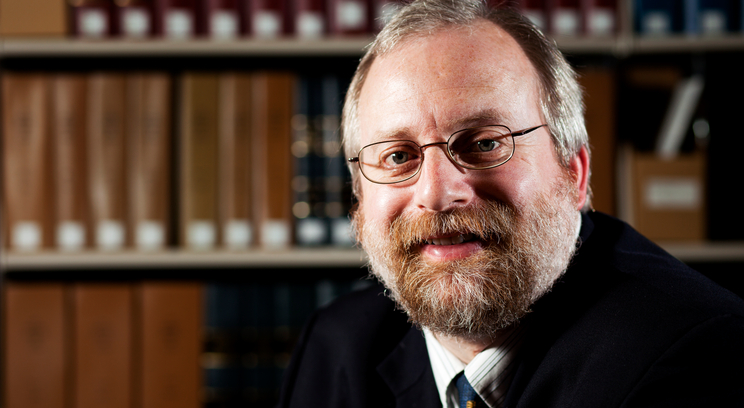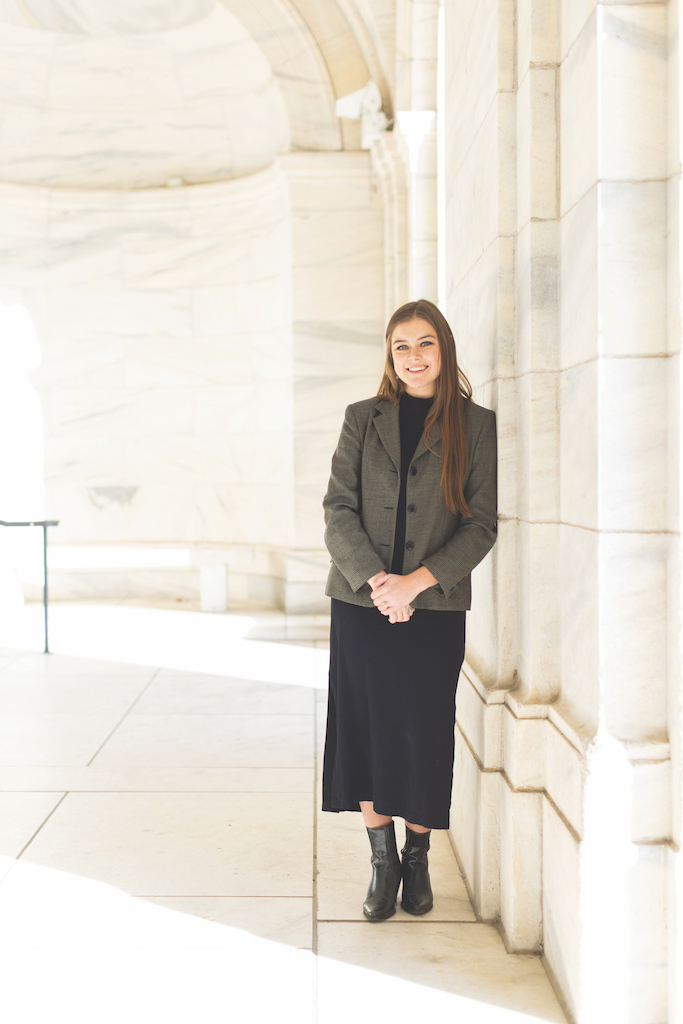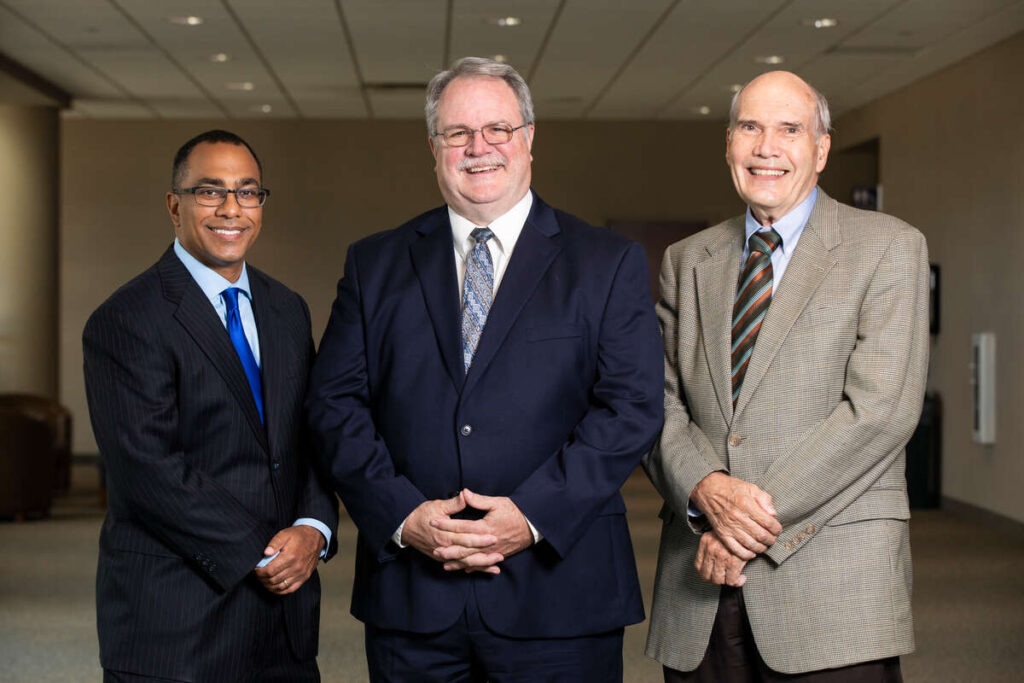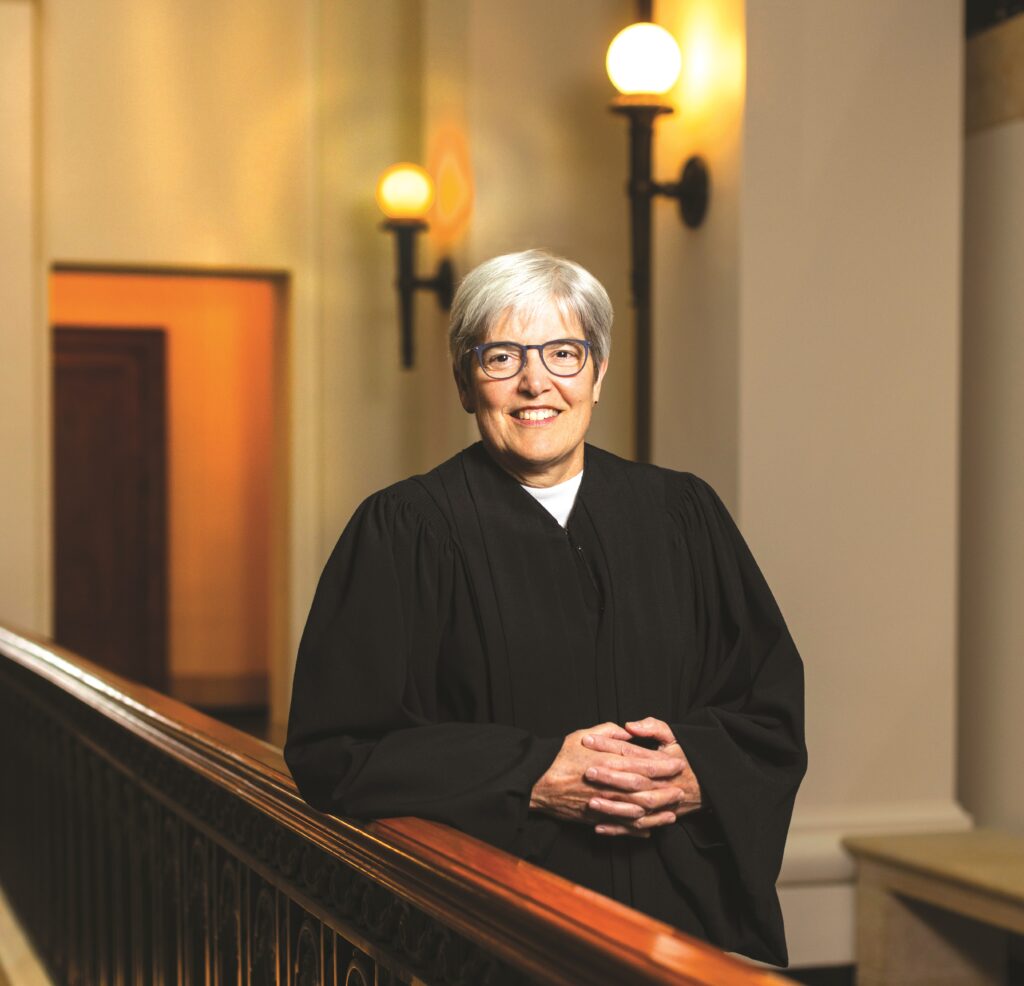A case recently decided by the U.S. Supreme Court focused on intellectual property rights. In Bowman v. Monsanto Co., the Court addressed the question of whether a farmer who buys patented seeds may reproduce them through planting and harvesting without the patent holder’s permission. The Court decided in favor of Monsanto. But was this, and other cases of intellectual property protection, best for the common good? Here, a law professor and a lawyer alumnus debate the question.
[ezcol_1half id="" class="" style=""]
Upholding IP Rights Advances the Common Good
by Andrew Pieper '03 B.A., '08 J.D.
 Consider: A farmer buys a mixture of soybean seeds from his local grain elevator to supplement his supply and plants them during the growing season. As he does with his other crops, the farmer uses an herbicide to treat the field where he planted the seeds. Many of the seeds grow into soybean plants, which flourish and mature, and the farmer harvests and sells his yield on the open market. Sometime later, however, the company that sold the farmer his herbicide – and also manufactures some of the seeds in the mixture the farmer purchased from the grain elevator – sues for patent infringement, alleging that the farmer had no right to plant, grow and sell the fruits of the company’s patented “seed technology” without its permission (and, of course, without paying the company a hefty license fee). The farmer had no way of distinguishing the company’s seeds from anyone else’s seeds in the mixture he bought; he just wanted to buy some cheap seeds in hopes of reaping a little extra money for his farming operation. Who should win?
Consider: A farmer buys a mixture of soybean seeds from his local grain elevator to supplement his supply and plants them during the growing season. As he does with his other crops, the farmer uses an herbicide to treat the field where he planted the seeds. Many of the seeds grow into soybean plants, which flourish and mature, and the farmer harvests and sells his yield on the open market. Sometime later, however, the company that sold the farmer his herbicide – and also manufactures some of the seeds in the mixture the farmer purchased from the grain elevator – sues for patent infringement, alleging that the farmer had no right to plant, grow and sell the fruits of the company’s patented “seed technology” without its permission (and, of course, without paying the company a hefty license fee). The farmer had no way of distinguishing the company’s seeds from anyone else’s seeds in the mixture he bought; he just wanted to buy some cheap seeds in hopes of reaping a little extra money for his farming operation. Who should win?
Now consider: An agriculture business wants to develop an effec- tive herbicide that prevents weeds and other noxious plants from growing in soybean fields. The problem? Its herbicides not only impact the growth of unwanted plants, but also kill off soybean plants. So the company spends decades of time and millions of dollars to develop both an herbicide and a soybean seed that, when used in concert, work to rid fields of problem plants while leaving the soybean plants unharmed. The company gets patents on its products – which become wildly successful in the marketplace – and, to protect itself, the company asks farmers to sign a license agreement as part of purchase whereby they promise not to save and replant seeds from a resulting crop. The company, however, discovers that a farmer – who signed a license agreement with the company – planted soybean seeds he purchased from a grain elevator (which are typically used as animal feed), treated his fields with the company's herbicide, and saved seeds from the crop to replant year after year without purchasing new seeds from the company. The company sues the farmer for patent infringement. Who should win?
These two scenarios present the opposing perspectives in Bowman v. Monsanto, a case recently before the Supreme Court. The case was portrayed largely as one of David versus Goliath; a small-town farmer trying to eke out a living against a multi-billion dollar multinational agricultural behemoth trying to preserve every dime of profit. Unlike in the biblical account, however, the Supreme Court in this case came down unanimously on the side of patent exhaustion – which says that all patent rights are terminated after the initial authorized sale of a patented item – did not relieve the farmer from his patent infringement. While many intellectual property practitioners and scholars agree this was the correct legal conclusion, many others, in the legal and nonlegal worlds, question whether monopolies on such technologies are moral and just. In this case, as in others, the answer is invariably yes, particularly when one considers how patents and other forms of intellectual property have advanced the common good.
Recognition of the importance of intellectual property protections dates back to the very founding of the United States; as Article I, Section 8 of the Constitution states, “[t]o promote Arts, by securing a limited Times to Authors and Inventors the exclusive Right to their respective Writings and Discoveries.” Thus, the Founders encouraged scientific and technological advancements in our burgeoning nation by providing inventors a time-limited exclusive right to their inventions, and, as a result, a legal and regulatory framework has developed to ascertain what inventions are and are not protectable under the Constitution.
The rationale for these rights is simple yet profound: In exchange for public disclosure of private ideas, the federal government provides inventors with a time-limited monopoly in which to capitalize on their inventions. This creates an inherent trade-off, in which the public and inventors both stand to gain and to lose. The inventor loses a competitive edge by publicly disclosing his invention, such that others can obtain insight into aspects of its development, including potential commercial applications. But the inventor gains a limited monopoly on the ability to capitalize on the invention, and a jump-start on any competitors who wish to compete in that market. The public loses some competition in the market, but gains access to the invention so as to push forward with new innovations related to the invention.
Promoting the Common Good
This inherent trade-off in intellectual property protections has created a ripe environment for significant discoveries in science and technology; indeed, since its founding, our nation has witnessed unprecedented advancement in science and technology. Consider, for example, the progress over the past 200-plus years in health care and medicine, agriculture, industrial processes, computing technology and any other field you can think of. Much of that progress is owed to private investments – in time, money and energy – by citizens and businesses seeking to capitalize on their own inventions. Constitutionally enshrined and legally sanctioned intellectual property protections provide incentives for those inventions and innovations. The trade-off for intellectual property protections allows inventors to recover some of the research and development costs in creating their advancements, which may (or may not) pay off down the road.
Private research and development is often done at a loss to for-profit entities. Businesses spend large sums of money on many inventions that ultimately do not create a return on investment. But that money is well invested if a business can gain a limited monopoly on the few inventions that may create a return in the long-run. The trade-off in intellectual property protections effectively establishes a public-private partnership, which works as a cycle of innovation that incentivizes investments into research for new and emerging technologies while publicly sharing that knowledge so others can further innovate.
Through economic incentives in exchange for public disclosure, this innovation cycle has, ultimately, advanced the common good – one of the central moral tenets of many faiths and particularly of Catholic social teaching. In its broadest sense, the common good stands for “the sum total of social conditions which allow people, either as groups or as individuals, to reach their fulfillment more fully and more easily.”1 As a result of scientific and technological advancements incentivized and protected through the intellectual property framework, life expectancy has increased, quality of life has improved, economic growth has been sustained, and people have more and better opportunities to live their lives to the fullest potential imaginable.
Yet, in the encyclical Caritas in Veritate, which outlined the church’s teaching on the degradation of charity and divisions of wealth within the global economic order, Pope Benedict XVI wrote: “On the part of rich countries there is excessive zeal for protecting knowledge through an unduly rigid assertion of the right to intellectual property, especially in the field of health care.”2 This comes at the end of a discussion on global inequalities of wealth, and the statement’s motivation likely relates to the affordability of patented medical technologies and the argument that the enforcement and lifespan of patents reduce health care access within impoverished classes of both rich and poor countries.
The primary reason that innovations in health care and other fields have succeeded in advancing the common good, however, is because of intellectual property protections and the economic incentives they afford. It is a simple reality that the motivation for most for-profit entities is, of course, to maximize profits and minimize losses. There is always a market for technological advancements that improve people’s lives, and advancements that have broad applications have potentially broad markets in which to sell. As a result, the potential return on investment for entities that can offer advancements is likewise very broad. There are great incentives to innovate and invent technologies with broad applications in order to compete in those markets, because they offer the opportunity to create more profits.
Before those innovations and inventions can be realized, however, people and companies must invest significant amounts of time and money in inventions that fail or only partially succeed. This is directly counterintuitive to the motivation of most businesses to minimize losses. Broad intellectual property protections offer the incentive to con- tinue investing in broad advancements, even if they’re unrealized for a period of time or if they're never realized. Thus, in order to justify losses incurred as a result of failed research, intellectual property protections are necessary in order for inventors to capitalize on their few successes. Limiting intellectual property protections, however, diminishes those economic incentives to invest in the research necessary to achieve those innovations, thus slowing technological progress and, ultimately, progress toward the common good that accompanies new technologies.
There is no doubt that some patented technologies are not freely or widely available to all. Unquestionably, vast discrepancies exist in health care, agriculture and other technologies, which are available in some parts of the world but not others. The cause of these discrepancies, however, is not that the technologies are locked up by intellectual property protections; rather, there are more systemic origins of those problems, including security, distribution and global trade practices. The best way to advance the common good through new technologies, therefore, is to not diminish or limit intellectual property protections; instead, it lies in the opening up of safe and legally secure markets where patented technologies can be more widely sold.
Author: Andrew Pieper ’03 B.A., ’08 J.D. is a business litigation associate at Robins, Kaplan, Miller & Ciresi L.L.P. The content of this article should not be taken as legal advice or as an expression of the views of the firm, its attorneys or any of its clients.
NOTES
1 Pope Paul VI, Gaudium et Spes, 26 (1965).
2 Pope Benedict XVI, Caritas in Veritate, 22 (2009).
[/ezcol_1half] [ezcol_1half_end id="" class="" style=""]
Constraining IP Rights Advances the Common Good
by Thomas Berg
 Andrew Pieper is half right, I think, when he defends broad intellectual property (IP), patents in particular, as an instrument for promoting the common good. Patents and copyrights give inventors and authors, respectively, the right to exclude others from using their creations for limited time periods: 20 years for a patent, 70 years from the author’s death for a copyright. Our legal tradition has valued these rights; the patent and copyright laws date back to the very first Congress. But the law also has hedged the rights with important limitations, reflecting the fact that exclusivity has costs and free access to ideas also plays a crucial role in promoting the common good. Unfortunately, this balance has gone awry in recent years, as IP laws have expanded unjustifiably.
Andrew Pieper is half right, I think, when he defends broad intellectual property (IP), patents in particular, as an instrument for promoting the common good. Patents and copyrights give inventors and authors, respectively, the right to exclude others from using their creations for limited time periods: 20 years for a patent, 70 years from the author’s death for a copyright. Our legal tradition has valued these rights; the patent and copyright laws date back to the very first Congress. But the law also has hedged the rights with important limitations, reflecting the fact that exclusivity has costs and free access to ideas also plays a crucial role in promoting the common good. Unfortunately, this balance has gone awry in recent years, as IP laws have expanded unjustifiably.
Patents’ exclusivity provides a means to encourage innovation by allowing the inventor to charge above-competitive prices and recoup research and development costs. Copyright provides similar incentives for creative works. Advances in technology and the arts promote human flourishing as a general matter (though not in every case) and therefore generally serve the common good as the Catholic tradition defines it: “the sum total of social conditions which allow people, either as groups or as individuals, to reach their fulfillment more fully and more easily.”1 Moreover, the Catholic tradition values private property not just because it produces goods, but because it promotes human dignity, preserving a sphere of freedom for persons and “stimulating [their] exercise of responsibility.”2
At the same time, the Catholic tradition views private property as a limited right, one that does not merely serve the individual but is an instrument for broader purposes. Property serves "an intrinsically social function" and is subject to a "social mortgage" for the satisfaction of the needs of others. Popes Benedict and John Paul II, among other church leaders, have appealed to these limits in recent years, criticizing an “unduly rigid” application of patent rights that has helped restrict access to affordable medicines for epidemics such as AIDS and malaria.
Actually, many traditional features of IP laws fit well with the Catholic conception of property as a limited, instrumental right. The Constitution authorizes Congress to pass copyright and patent laws for an instrumental goal – “to promote the progress of science and the useful arts” – and it explicitly requires that their protections run only “a limited time.”3 The premise is that innovation and progress are served not only by granting exclusive rights to reward creators, but also by setting limits to those rights so that others can build freely on materials to do their own innovation. Accordingly, IP statutes and case-law doctrines draw numerous lines between protected and unprotected material and contain various limitations on exclusive rights. Copyright, for example, protects only specific expression, not general ideas, and contains 16 statutory sections of exceptions to exclusive rights. Patent law historically has denied protection to, among other things, abstract ideas, “obvious” advances in technology, and inventions that are not sufficiently clearly delineated in the patent.
Creators’ Rights Versus Public Access
Recently, however, IP has expanded in ways that have upset the balance between creators’ rights and public access. It’s impossible to be exhaustive in this short exchange, but here are three examples.
First, recent evidence indicates that patents often discourage innovation rather than encourage it, and that a major reason may be that getting a patent is too easy. An innovating firm typically must consider not only its patents, which generate revenue, but also others' patents, which may impede its innovation plans. The question is whether the gains from its patents out-weigh the costs from others’. Empirical research by scholars James Bessen and Michael Meurer, summarized in their 2008 book Patent Failure, shows that during the 1980s and 1990s, outside of the chemical and pharmaceutical industries, publicly traded companies spent substantially more defending against patent lawsuits than they reaped from their patent portfolios. For software firms in particular, litigation costs swamped patent value.
Bessen and Meurer conclude that the costs, which increased noticeably in the 1990s, reflect largely an increase in the occurrence of litigation. While this in turn rests on several factors,
one key, they conclude, is that many more patents were allowed based on relatively “abstract” general language that could cover multiple settings. For years, courts had denied patent protection to methods of doing business – for example, processes for maximizing investment returns or ordering goods online – and had limited patents on software to specific applications. That all changed in the 1990s as the Federal Circuit, a court newly created to handle patent cases, took a decidedly pro-patent position. With lenient patenting standards and a flood of new applications, the U.S. Patent and Trademark Office (PTO) was unable to cull software, business-method, and biotechnology patents down to manageable numbers or scope.
Bessen and Meurer’s findings fit the experience of many in the soft- ware and financial industries. A 2009 brief filed in the U.S. Supreme Court by Google, Metlife, Bank of America, Morgan Stanley and others said, “The recent surge in patents on abstract ideas such as how to run a business or software that merely implements such methods has not promoted innovation in the financial services or information technology fields – to the contrary, such patents create a drag on innovation.” This is not an argument for eliminating patents (although we might think about an alternative system for protection for software); rather, it’s an argument for making the system work better. But for that to happen, we must be vigilant about limits on what can be patented.
The scope of patentable material in biotechnology also got out of hand. In the last 30 years, for example, the PTO allowed thousands of patents on portions of the human genome, covering at least 20 percent of our genes, perhaps much more. Patent law historically excluded naturally occurring phenomena; you cannot gain ownership over a species of plant that you discover in the Amazon rainforest. But many recently issued patents extended to gene sequences in the very form they occurred in the body, simply because the patent holder had isolated them from the rest of the genome. This development raised moral and theological concerns about human ownership of features of nature (concerns accentuated in the case of features of the human body): Catholic and other religious traditions affirm these features as created by God, not by biotech scientists. Such patents also gave their holders potentially damaging monopolies over all research, testing, and therapies based on the gene. But the U.S. Supreme Court restored some balance this June by holding that Myriad Genetics could not patent the isolated “breast cancer genes,” BRCA1 and BRCA2, because they were natural phenomena.4 Genetics companies may still gain returns through patents on particular inventive tests and on artificial DNA synthesized in the process. But the basic building block, the gene sequence itself, will be open to researchers and to companies developing competing tests.
Second, excessive protection of patents and copyrights may not only interfere with further innovation; it may have other effects on users and thus on the common good. Patents on genetically modified (GM) seeds – the example with which Pieper begins his article – may benefit farmers economically, but they also change farming practices that are generations old, such as the reuse of seeds for the next year’s crop. Farmers become licensees of Monsanto, subject to ongoing investigation and control of their behavior under licensing agreements. As Pieper notes, the Supreme Court recently held unanimously that a farmer, Vernon Bowman, could not intentionally replant GM seeds to grow a second crop of herbicide-resistant soybeans, because that would undercut the company’s return on its patented technology.5 The Court, however, left open other questions such as whether a farmer can be liable for harvesting crops from GM seeds that drift onto his property. Monsanto has stated it will not sue farmers over “trace amounts” of GM seeds. But that is not a binding commitment, and there are a host of uncertain situations in between “trace amounts” and Bowman’s systematic replanting.
The Bowman case involved the “exhaustion” doctrine, an important limit on patents that provides that once a patented article is sold, the article's owner may resell it or use it in various ways (for example, repairing it). Copyright’s version of exhaustion is the “first sale” doctrine, which allows the resale or lending of copyrighted articles such as books and movie DVDs. Both doctrines are meant to preserve individuals’ freedom over their personal property. But neither doctrine allows the owner to make a new copy of the article, which is what the Court held Bowman had done by replanting his seeds.
The prohibition on copying creates a complication, however, concerning digital creations: virtually every use of them involves making a copy, even the sort of uses that would clearly be permissible in a nondigital context. Copyright holders have exploited this fact to seek greatly expanded control over users of their works. Most recently, Capitol Records won a lawsuit against Redigi, the website that allows individuals to sell their MP3 music files to each other. Redigi approximated the mere transfer of a physical copy, as in a used DVD store, because it required a user to delete his own file upon selling the copy to another; nevertheless, the court held the "first sale" doctrine inapplicable because the process created a new copy, although not an additional one. The logic renders the idea of exhaustion of rights completely inapplicable to digital creations, giving copyright holders far broader control over “downstream” uses of works than they’ve had in previous copyright contexts.
Exhaustion is not the only area where traditional limits on exclusive rights have receded or been side-stepped. Software providers rely systematically on standard-form licenses, with no bargaining on terms, that limit uses far more than the rules of copyright do. The fair-use doctrine – a crucial limit on copyright that protects uses of works for research, critical commentary, education and other purposes that advance the common good – is under pressure from copyright holders who argue a use can never be fair if it deprives the holder of licensing fees he might have collected. We need to preserve the strength of traditional limits on IP rights, whether that requires new legislation or the interpretation of existing provisions.
Promoting the Common Good
And third, developing countries have been pressured to extend their domestic intellectual property laws in ways that do not serve the common good of their citizens. Beginning in 1994, at the behest of IP-producing nations such as the United States, the major global trade instrument, the General Agreement on Tariffs and Trade (GATT), added a section requiring that all signatories, including developing countries, protect patents and copy-rights. Around the same time, pharmaceutical companies began clashing with developing countries over the prices of patented medicines for epidemics like AIDS and malaria.
Pieper acknowledges that important patented innovations, especially medicines, are still widely unavailable in the least-developed countries (LDCs). He argues, however, that the causes are primarily “security and distribution” problems, “not that the technologies are locked up by intellectual property protections.” The other factors play a role, but unquestionably part of the problem has been costs propped up by patents. In the early 2000s, for example, a year’s supply of a combination of patented AIDS drugs cost more than $10,000, while Indian generic producers offered a similar cocktail for under $400. Yet drug companies sued to block the introduction of generic medicines in developing countries.
Under pressure from developing countries and relief organizations, trade negotiators gave LDCs more lead time to adopt global patent requirements and also clarified that in public-health crises those countries could create exceptions to patent rights, such as compulsory licenses at more affordable prices. These adjustments were correct. For an LDC, full-fledged patent rights can easily fail to serve the common good and human dignity; the need for low-cost goods, especially essentials such as medicines, tends to be immediate and overwhelming, and patent rights cannot be expected to stimulate a domestic industry leading to self-sufficiency.
Columbia economist Jagdish Bhagwati wrote a book titled In Defense of Globalization, but even with his pro-globalization approach he argued that exceptions to the new global patent requirements were necessary for these epidemics. For disease (such as malaria) exclusively or primarily found in poor nations, patents have spurred little pharmaceutical research or production (currently, less than 2 percent of overall medical R&D), because monetary demand confined to poor nations was insufficient to generate returns. For diseases (such as AIDS) found in both poor and developed nations, companies used patents to try to keep prices and returns in poor countries as high as possible while inducing aid foundations and NGOs “to give money to the poor countries to buy the drugs at [the higher] prices.” The companies claimed this was necessary because cheap drugs might be exported to the United States, but there was little evidence that was a real threat.
Voluntary agreements among drug companies, LDCs, and NGOs have increased the distribution of affordable medicines somewhat. But massive challenges still remain – and as part of the solution, LDCs need to have flexibility to put immediate needs above the speculative promises of long-term benefits from full patent enforcement.
At meetings of the World Trade Organization, which administers global trade agreements, representatives from the Vatican repeatedly have stated that IP deserves protection “to create incentives for innovation,” but that protection must be tempered to “sprea[d] the benefits of the innovations as widely as possible," since "the very creative and innovative impetus" that IP rights provide “is there to serve the common good of the [entire] human community.”6 Those general principles do not decide how far IP protection should go, of course, but they describe the balance just about right.
Author: Thomas Berg is the James L. Oberstar Professor of Law and Public Policy at the School of Law. He teaches intellectual property, constitutional law and religious liberty.
NOTES
1 Pope Paul VI, Gaudium et Spes, 26 (1965).
2 Id. 71.
3 U.S. Const., art. I, §8, cl. 8.
4 Association for Molecular Pathology v. Myriad Genetics, ___ S.Ct. ___, 2013 WL 2631062 (June 13, 2013).
5 Bowman v. Monsanto Co., 133 S. Ct. 1761 (May 13, 2013).
6 See Thomas C. Berg, Intellectual Property and the Preferential Option for the Poor, 5 Journal of Catholic Social Thought 193, 198 (2008) (quoting Vatican statements).
Read more from St. Thomas Lawyer.
[/ezcol_1half_end]







